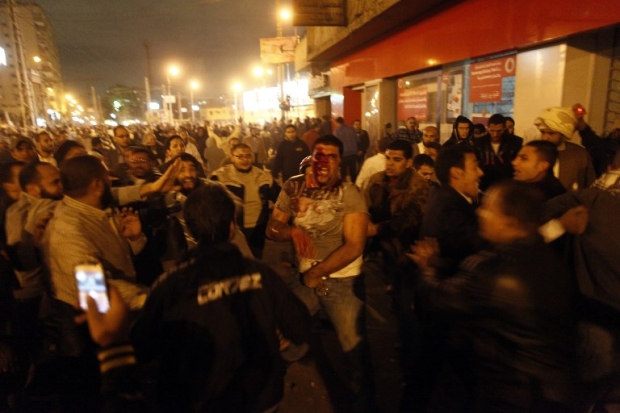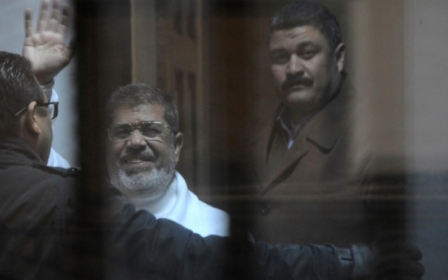Ittihadiya clashes: Planned coup or deadly attack on sit-in?

On 5 December 2012, clashes broke out between members of the Muslim Brotherhood and protesters that would leave 11 Egyptians dead.
The protesters took to the streets to reject a constitutional amendment issued by President Mohamed Morsi on 22 November 2012. The decree would have allowed him to issue any decision or law leaving any alternative authority without the power to oppose or revoke it.
Morsi portrayed the amendment as an attempt to protect the country’s slow transition to a constitutional democracy. Opposition groups, however, sharply criticised the decision.
On the same evening Morsi announced the decree, opposition leaders, including former presidential candidates Mohammed El-Baradei, Amr Moussa and Hamdeen Sabahi, held a press conference calling for the immediate annulment of the decree, a reformed constituent assembly and a law on transitional justice, while calling for strong protests all over Egypt.
Shortly after, protesters who believed the decree was really a move to grant Morsi extrajudicial powers headed for the presidential palace in Cairo’s eastern Heliopolis suburb.
Morsi supporters gathered around the palace to “protect their president” from what they saw as an attempted coup six months after he had been elected.
According to one narrative illustrated in an Aljazeera documentary titled The Night of Ittihadiya, as hundreds of anti-Morsi protesters started to gather around the palace, police and security forces left the site surprisingly unguarded.
According to reports, opposition figures including presidential candidates Moussa, Sabahi and el-Baradie had called for protests to bring down Morsi.
Tareq al-Gohary, a member of the security forces assigned with guarding Morsi at the time, went as far as claiming that opposition members attempted to assassinate Morsi when they entered the palace that night, reported Aljazeera.
Families of the Brotherhood victims allege that on the night of 5 December 2012, after which anti-Morsi protesters emptied their tents and left the vicinity of the palace, some demonstrators returned, said alternative news network Rassd in a report it compiled in 2014.
According to the report, this time the protesters - or thugs - were carrying weapons and started attacking Brotherhood supporters, while security forces around the palace either left their positions or stood by idly watching as the violence escalated.
Another narrative, however, claims that Morsi supporters initiated the next-day clashes, ripping down anti-Morsi protesters' tents and allegedly torturing them.
Video footage from the clashes and reports on the day show Morsi supporters beating the opposition, tying one protester to the palace doors and torturing another until he confessed to being a paid thug.
At the time, activists and journalists posted images on Twitter alleging that the president’s supporters dispersed the sit-in and took control of the area outside the palace, with the apparent acquiescence of the police.
Eleven people, eight of whom were Morsi supporters, were killed in the violence that unfolded.
A day later, Morsi used a televised address to blame a "fifth column", saying remnants of the Mubarak regime had been "hiring thugs and giving out firearms". He said he refused to tolerate anyone working to overthrow his "legitimate" government.
"It is my duty to defend the homeland," he said.
He also agreed to limit the scope of his controversial amendment to "sovereign matters” while insisting on keeping his right to protect the constituent assembly.
At a court hearing in Cairo on Tuesday, in which Morsi was acquitted of murder charges related to the clashes, only the deaths of a journalist, Hosseini Abu Deif, and two anti-Morsi demonstrators were addressed. The cases of the eight Muslim Brotherhood members and supporters killed during the clashes were not mentioned during the trial.
The case had also initially charged 14 Brotherhood leaders alongside Morsi with the killing of protesters, and the incitement of violence during the Ittihadiya events.
While what happened to the cases of the eight Brotherhood members who were killed in the clashes remains unclear, 12 Brotherhood leaders - including Essam al-Erian and Mohamed el-Beltagy - were sentenced to 20 years in prison along with Morsi.
The remaining two defendants, one of whom was a member of Salafist Hazem Abu Ismail's presidential campaign, each received a 10-year prison sentence, reported al-Shorouk newspaper.
Middle East Eye propose une couverture et une analyse indépendantes et incomparables du Moyen-Orient, de l’Afrique du Nord et d’autres régions du monde. Pour en savoir plus sur la reprise de ce contenu et les frais qui s’appliquent, veuillez remplir ce formulaire [en anglais]. Pour en savoir plus sur MEE, cliquez ici [en anglais].





